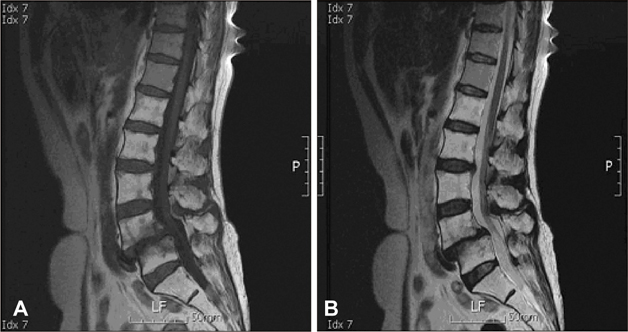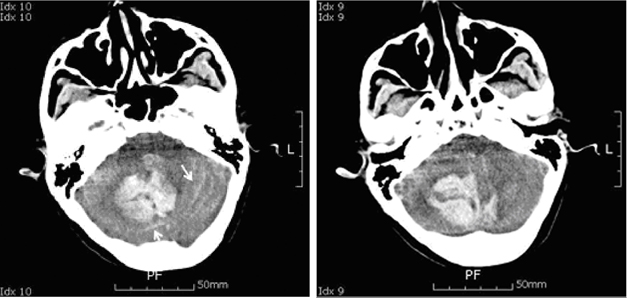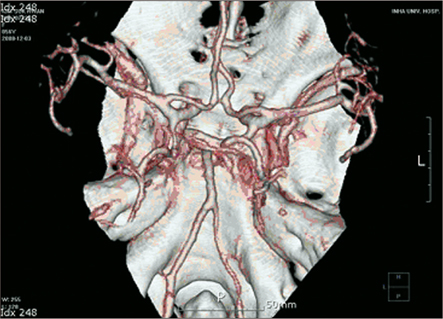J Korean Neurotraumatol Soc.
2010 Dec;6(2):162-164. 10.13004/jknts.2010.6.2.162.
Remote Cerebellar Hemorrhage after Spinal Surgery
- Affiliations
-
- 1Deparment of Neurosurgery, Inha University Hospital, School of Medicine, Inha University, Incheon, Korea. nspco@inha.ac.kr
- KMID: 2106805
- DOI: http://doi.org/10.13004/jknts.2010.6.2.162
Abstract
- This report details a case of a 56-year-old woman who presented with a herniated lumbar disc at L4-5 with congenital spondylolisthesis (grade II) and developed remote cerebellar hemorrhage following an iatrogenic acute reduction in cerebrospinal fluid (CSF) pressure during spinal interbody fusion. Possible mechanisms are discussed: however, pathological events leading to this complication are unclear. Intracranial hemorrhage (ICH) must be considered in patient presenting with unexplained neurological deterioration not attributable to the spinal surgery, especially when the dura has been opened followed by significant CSF loss.
Figure
Reference
-
1. Andrews RT, Koci TM. Cerebellar herniation and infarction as a complication of an occult postoperative lumbar dural defect. AJNR Am J Neuroradiol. 1995; 16:1312–1315.2. Brockmann MA, Nowak G, Reusche E, Russlies M, Petersen D. Zebra sign: cerebellar bleeding pattern characteristic of cerebrospinal fluid loss. Case report. J Neurosurg. 2005; 102:1159–1162.3. Cevik B, Kirbas I, Cakir B, Akin K, Teksam M. Remote cerebellar hemorrhage after lumbar spinal surgery. Eur J Radiol. 2009; 70:7–9.
Article4. Chadduck WM. Cerebellar hemorrhage complicating cervical laminectomy. Neurosurgery. 1981; 9:185–189.
Article5. Friedman JA, Ecker RD, Piepgras DG, Duke DA. Cerebellar hemorrhage after spinal surgery: report of two cases and literature review. Neurosurgery. 2002; 50:1361–1363. discussion 1363-1364.
Article6. Gelfenbeyn M, Vasil'ev S, Krylov V. Cerebellar haemorrhage after supratentorial aneurysm surgery with lumbar drainage. Neurosurg Rev. 2001; 24:214–219.
Article7. Konya D, Ozgen S, Pamir MN. Cerebellar hemorrhage after spinal surgery: case report and review of the literature. Eur Spine J. 2006; 15:95–99.
Article8. Mikawa Y, Watanabe R, Hino Y, Ishii R, Hirano K. Cerebellar hemorrhage complicating cervical durotomy and revision C1-C2 fusion. Spine (Phila Pa 1976). 1994; 19:1169–1171.
Article9. Morandi X, Riffaud L, Carsin-Nicol B, Guegan Y. Intracerebral hemorrhage complicating cervical "hourglass" schwannoma removal. Case report. J Neurosurg. 2001; 94:150–153.10. Park CO, Chae KB, Lee SD, Kim Y, Ha YS. The study in frontal ventricular measurement and correlation between cerebroventricular index and cephalic index on normal computed tomography. J Korean Neurosurg Soc. 1990; 19:608–614.11. Satake K, Matsuyama Y, Iwata H, Sato K, Kawakami N. Cerebellar haemorrhage complicating resection of a cervical intramedullary tumour. Spinal Cord. 2000; 38:504.
Article12. Thomas G, Jayaram H, Cudlip S, Powell M. Supratentorial and infratentorial intraparenchymal hemorrhage secondary to intracranial CSF hypotension following spinal surgery. Spine (Phila Pa 1976). 2002; 27:E410–E412.
Article13. Yoshida S, Yonekawa Y, Yamashita K, Ihara I, Morooka Y. Cerebellar hemorrhage after supratentorial craniotomy--report of three cases. Neurol Med Chir (Tokyo). 1990; 30:738–743.
- Full Text Links
- Actions
-
Cited
- CITED
-
- Close
- Share
- Similar articles
-
- Remote Cerebellar Hemorrhage after Intradural Disc Surgery
- Remote Cerebellar Hemorrhage after Lumbar Spinal Surgery
- Remote Cerebellar Hemorrhage After Supratentorial Aneurysm Surgery: Report of 2 Cases
- Remote Cerebral and Cerebellar Hemorrhage after Massive Cerebrospinal Fluid Leakage
- Remote Cerebellar Hemorrhage Presenting with Cerebellar Mutism after Spinal Surgery: An Unusual Case Report




